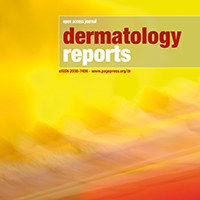Case series of cutaneous Langerhans cell histiocytosis in Indonesian children; The clinicopathological spectrum

Accepted: 23 September 2020
HTML: 228
All claims expressed in this article are solely those of the authors and do not necessarily represent those of their affiliated organizations, or those of the publisher, the editors and the reviewers. Any product that may be evaluated in this article or claim that may be made by its manufacturer is not guaranteed or endorsed by the publisher.
Langerhans Cell Histiocytosis (LCH) is a rare disease characterized by the clonal proliferation of Langerhans cells, which are immunoreactive to S-100 and CD-1a/ CD207 (Langerin). Cutaneous involvement is the most common presentation of LCH in children. It is suggested that the patients with single-system LCH limited to the skin have a better prognosis than those with systemic involvement. Three histologic reactions of cutaneous LCH have been reported and are associated with the clinical types of LCH. These histological reactions include: proliferative, granulomatous, and xanthomatous. This study presents the clinicopathological features of ten cutaneous LCH cases collected from Dr. Sardjito General Hospital Yogyakarta Indonesia between 2014-2018. The ten cases showed various clinical features, in which some features mimic other diseases. The microscopic features of skin biopsies showed granulomatous reaction in 80% of cases and proliferative reaction in the other 20%. Five patients (50% of cases) who died had systemic manifestation of thrombocytopenia, anemia, icterus, hepatosplenomegaly, and revealed the granulomatous type from their skin biopsy specimens. The clinical recognition of LCH and subsequent histological reaction determination are important since some cases may develop multisystem disease and have a poor prognosis.
2. Querings K, Starz H, Balda BR. Clinical spectrum of cutaneous Langerhans' cell histiocytosis mimicking various diseases. Acta Derm Venereol. 2006;86(1):39-43.
3. Park SH, Park J, Hwang JH, et al. Eosinophilic granuloma of the skull: a retrospective analysis. Pediatr Neurosurg. 2007;43(2):97-101.
4. Lam S, Reddy GD, Mayer R, et al. Eosinophilic granuloma/Langerhans cell histiocytosis: pediatric neurosurgery update. Surg Neurol Int. 2015;6(Suppl 17):S435-9.
5. Cassarino D, Dadras S. Diagnostic Pathology, Neoplastic Dermatopathology 2nd ed. Philadelphia: Elsevier 2017.
6. Romano R, Shon W, Jenkins S, KJ F. BRAF V600E Immunohistochemistry in cutaneous Langerhans cell histiocytosis: an analysis of 20 cases. Int J Pathol Clin Res. 2016;2.
7. Simko SJ, Garmezy B, Abhyankar H, et al. Differentiating skin-limited and multisystem Langerhans cell histiocytosis. J Pediatr. 2014;165(5):990-6.
8. Tran G, Huynh TN, Paller AS. Langerhans cell histiocytosis: a neoplastic disorder driven by Ras-ERK pathway mutations. J Am Acad Dermatol. 2018;78(3):579-90 e4.
9. Jezierska M, Stefanowicz J, Romanowicz G, et al. Langerhans cell histiocytosis in children - a disease with many faces. Recent advances in pathogenesis, diagnostic examinations and treatment. Postepy Dermatol Alergol. 2018;35(1):6-17.
10. Punia RS, Bagai M, Mohan H, Thami GP. Langerhans cell histiocytosis of skin: a clinicopathologic analysis of five cases. Indian J Dermatol Venereol Leprol. 2006;72(3):211-4.
11. Utsav S, Geng S. Cutaneous langerhans cell histiocytosis: report of two cases. Am J Case Rep. 2011;12:154-8.
12. Elder D, Elenitsas R, Rubin A, et al. Atlas and synopsis of Lever’s Histopathology of the skin 3rd ed. Philadelphia: Lippincott Wlliam & Wilkins; 2013.
13. Schmidt S, Eich G, Hanquinet S, et al. Extra-osseous involvement of Langerhans' cell histiocytosis in children. Pediatr Radiol. 2004;34(4):313-21.
14. Haupt R, Minkov M, Astigarraga I, et al. Langerhans cell histiocytosis (LCH): guidelines for diagnosis, clinical work-up, and treatment for patients till the age of 18 years. Pediatr Blood Cancer. 2013;60(2):175-84.
15. Stein SL, Paller AS, Haut PR, Mancini AJ. Langerhans cell histiocytosis presenting in the neonatal period: a retrospective case series. Arch Pediatr Adolesc Med. 2001;155(7):778-83.
16. Patterson J. Weedon’s Skin Pathology 4 th ed. London: Churchill Livingstone Elsevier; 2016.
17. Allen CE, Ladisch S, McClain KL. How I treat Langerhans cell histiocytosis. Blood. 2015;126(1):26-35.
18. Heritier S, Emile JF, Barkaoui MA, et al. BRAF mutation correlates with high-risk Langerhans cell histiocytosis and increased resistance to first-line therapy. J Clin Oncol. 2016;34(25):3023-30.
19. Sasaki Y, Guo Y, Arakawa F, et al. Analysis of the BRAFV600E mutation in 19 cases of Langerhans cell histiocytosis in Japan. Hematol Oncol. 2017;35(3):329-34.
20. Berres ML, Merad M, Allen CE. Progress in understanding the pathogenesis of Langerhans cell histiocytosis: back to histiocytosis X? Br J Haematol. 2015;169(1):3-13.
PAGEPress has chosen to apply the Creative Commons Attribution NonCommercial 4.0 International License (CC BY-NC 4.0) to all manuscripts to be published.





 https://doi.org/10.4081/dr.2020.8777
https://doi.org/10.4081/dr.2020.8777



